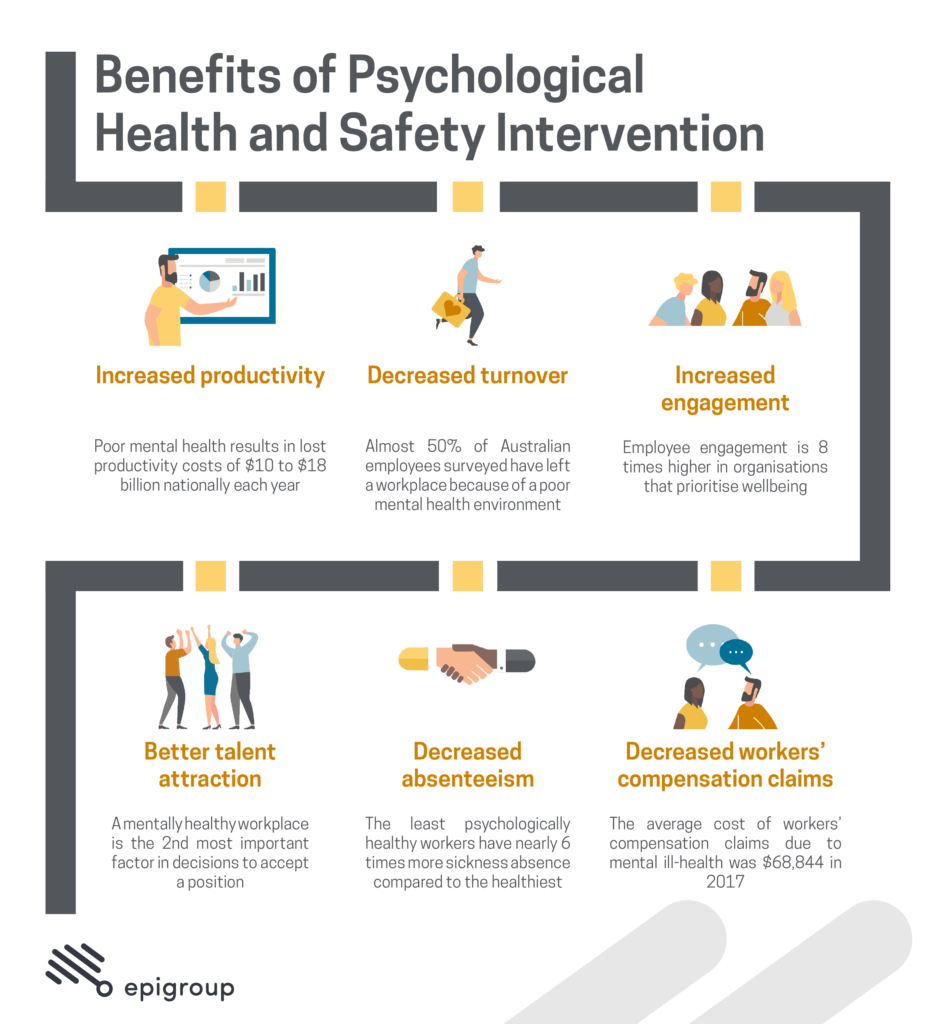Updated: September 2024
Workplaces haven’t been the same since the pandemic. Hybrid working models and online meetings are the new norm, alongside a huge focus on employee mental health and wellbeing.
Since the pandemic, 85% of workers report declining mental health. Psychosocial hazards and risks are now treated the same as physical hazards and risks under WHS law, so the spotlight is on employers and what they’re doing to help their employees thrive.
“Proactively managing psychosocial hazards at work not only protects workers, it also benefits businesses by improving organisational performance and productivity,” says Marie Boland, CEO, Safe Work Australia in their recent report on psychological health and safety.
Employers can now be prosecuted for not providing appropriate working conditions or support, and it can cost a business tens of thousands of dollars – the median compensation paid for mental health conditions was $58,615 per serious claim compared to $15,743 per serious claim for all injuries and diseases, according to the report.
The stats also showed that mental health conditions led to greater time away from work, with “the median time lost for mental health conditions over the same period was 34.2 working weeks per serious claim compared to 8.0 working weeks per serious claim for all injuries and diseases.”
So let’s find out more about psychosocial hazards, examples, legal obligations, and what you can do to look after your employees.
Psychosocial Risk Management Services
What Are Psychosocial Hazards?
Psychosocial hazards are factors in the workplace that can cause a worker psychological or physical health. These factors include:
- workplace systems
- management
- workload
- social interaction
- environments, and
- culture.
According to Safe Work Australia, of the approximately 10,000 serious mental stress claims in 2021-22, the highest proportion were attributed to:
- Work related harassment and/or workplace bullying (27.5%)
- Work pressure (25.2%)
- Exposure to workplace or occupational violence (16.4%)
Although psychosocial hazards aren’t new, the awareness of them has intensified since the Work Health and Safety Act 2020 came into effect in March 2022. We’ll get into the legal stuff later, first here are some examples of common psychosocial hazards.
Examples of Psychosocial Hazards
| Psychosocial Hazard or Risk Factor | Description | Example |
| High Work Demands | This can include high levels of physical, mental or emotional effort needed to do a task or job |
|
| Low levels of Control | When workers have little control or say over the work |
|
| Inadequate Support | When workers are not getting enough support from supervisors or other workers, or not having the resources needed to do the job well |
|
| Remote or Isolated Work | Work that is isolated from the assistance of others because of the location, time or nature of the work |
|
| Inappropriate and unreasonable behaviour | Harmful behaviours become a hazard when it is severe, prolonged or frequent |
|
Some of these examples of psychosocial hazards may seem easy to manage when isolated, however their level of impact or risk can increase when a combination comes into play.
For example, if a job requires the high demand of extended hours of work, causing a worker fatigue, this could be managed by reducing working hours to ensure that an employee is well rested. However, if they’re also dealing with stress or anxiety from working remotely, this may impact their ability to rest, and get the support they need. In addition to that, an individual’s response to psychosocial risks and hazards can vary greatly depending on several factors such as age, health status, social status, and personal experience.
Psychosocial issues are generally easier to hide than physical injuries, but there are a number of strategies that can help you spot them including:
- Observing workplace interactions and behaviour, and gauging workplace culture
- Reviewing organisational structure
- Observing how work tasks are completed
- Consulting with workers, and safety and health representatives
- Inspect the physical workplace
- Analysing workplace data, such as incident reports
- Review work arrangement and job design
For example, in mining or construction role, a review of work arrangement could identify shift work as a psychosocial hazard.
Your Legal Obligations
When the WHS Act 2020 came in, the definition of ‘health’ was updated to describe not only the physical state of workers, but also their psychological state. By extension, the obligation of a Person Conducting a Business or Undertaking (PCBU) also extended to ensure the psychological safety of its workers. If you’re unsure what a PCBU is, it’s essentially an employer, but our explainer video goes into more details here.
The WHS Act stipulates the PCBU must ensure, so far as is reasonably practicable, the health and safety of workers and the health and safety of others is not put at risk. This is known as the primary duty of care.
The primary duty also requires the PCBU to:
- Provide and maintain safe systems of work (this includes any time a worker’s activities are directly influenced by the PCBU)
- Provide adequate facilities for the welfare of workers
- Provide information, training, instruction, or supervision necessary to protect workers; and
- Monitoring workplace conditions to ensure the health of workers.
It’s this primary duty of care that makes it crucial for organisations to take psychosocial hazards seriously, and to implement systems to ensure a person’s mental well-being is not put at risk.
Under the WHS Act, workers have a duty to take reasonable care for their own health and safety and to not adversely affect the health and safety of other persons. Workers must comply with reasonable instructions, as far as they are reasonably able, and co-operate with reasonable health and safety policies or procedures that have been notified to workers.
We’ve already seen the first charges laid against an organisation. On 28 July 2020, a Royal Australian Air Force technician took his own life while on duty at Williamtown Airforce Base. It is alleged the Department of Defence failed to manage the risks to psychological health and safety, and breached its duty under section 19(1) of the WHS Act by not providing, so far as reasonably practicable:
- Safe systems of work
- Necessary training to workers
- Information necessary to protect all persons from risks to their health and safety.
The three criminal charges brought against the Department of Defence include:
- One Category 2 offence, carrying a maximum penalty of $1.5 million
- Two Category 3 offences, each carrying a maximum penalty of $500,000
These charges demonstrate how seriously psychosocial hazards are treated, and the importance of managing the risks faced by workers. The complex nature of psychosocial hazards can make them seem challenging to manage, but there are proven strategies to ensure the mental well-being of workers.
Benefits of a psychosocially safe workplace
In addition to there being a legal requirement for organisations to manage psychosocial risk, there are plenty of perks for PCBUs to strive to create a psychosocially safe workplace.
Increased productivity
The Productivity Commission reported in 2019 that mental disorders result in lost productivity costs of $10-18 billion nationally each year.
Better talent attraction
According to a study by Beyond Blue, a mentally healthy workplace is the second most important factor in decisions to accept a position.
Decreased turnover
Beyond Blue also found that almost 50% of Australian employees surveyed have left a workplace because of a poor mental health environment.
Increased engagement
The World Economic Forum found employee engagement is 8 times higher in organisations that prioritise wellbeing.
Decreased workers’ compensation claims
Guess how much the average cost of a worker’s mental ill-health compensation claim was in 2017? According to Safe Work, it was $68,844!
Decreased absenteeism
A study by Safe Work Australia found the least psychologically healthy workers have nearly six times more sickness absence compared to the healthiest.
How to Manage Psychosocial Hazards
Part 1: Management Methods
Workplaces can use established methods to manage psychosocial hazards in the workplace by:
Identifying the hazards
Consider the design and management of work, the work environment, the workplace and interactions and behaviour to identify psychosocial hazards.
Assessing the associated risks
Consider the workers affected by those psychosocial hazards and the duration, frequency, and severity of their exposure.
For example, for shift work this can include considering shift length, physical exposures during the shift, the potential for fatigue, and how this can impact workers’ physical and mental health.
Implementing control measures
Controls are used to eliminate or minimise risks. If it is not reasonably practicable to eliminate the risks, you must minimise risks so far as is reasonably practicable.
For example, to manage the risk of shift work fatigue, rosters can be designed to ensure that workers have adequate time for rest and recovery.
Additionally, it’s important when implementing controls to acknowledge the individual needs of workers, it’s important to consult with workers to ensure the control is effective.
Regularly reviewing control measures
Controls should be regularly reviewed to ensure they are effective and working as planned.
In addition, a review should take place when:
- Consultation with workers’ or health and safety representatives highlights challenges or concerns
- A new hazard or risk is identified
- A significant workplace change is planned
Part 2: WHS Measures
There are several WHS measures you can take to help mitigate psychosocial risks.
Some of these you can do yourself, or if you’d like our team do it for you, please get in touch.
1. Psychosocial risk surveys and assessments – identify and assess the psychosocial risks in your workplace in order to establish effective control measures and satisfy legal obligations.
2. Psychosocial risk strategy facilitation and development – develop a strategic roadmap with achievable goals and actions for psychosocial risk management that ensures you create the best possible workplace for your people.
3. Training workshops – up-skill your people and fill any gaps in knowledge, skills, or abilities. For example, we put our consultants through mental health first aid training so they can spot the signs when a friend, colleague, family member or a client’s employee is struggling.
4. Coaching – deep dive into specific situations, or a more focused approach to the development of leaders, supervisors, or teams. Good coaching should teach you how to solve problems and identify the strategies that work for you.
5. FlourishDx – this versatile, well-rounded mental health platform enables the administration of psychosocial risk assessments as well as daily check-in surveys and a library of wellbeing resources. We’ve recently implemented FlourishDx for our employees, and if you’d like us to do the same for you, please reach out.
Creating an environment of psychological safety can contribute to the management of psychosocial hazards in the workplace. Having regular conversations and communication (both formal and informal) about mental health in the workplace can help workers, management, and leadership feel comfortable being honest about mental health. This can contribute to the identification of job factors that are negatively impacting – or have potential to impact – your workers’ mental health.
Worker health aside, improving mental health is good for business. As we’ve explored, the returns on investment per dollar invested into workplace health promotion interventions is estimated at $2.86 for small-medium enterprises, and $4.01 for large employers. And that’s no small feat!


